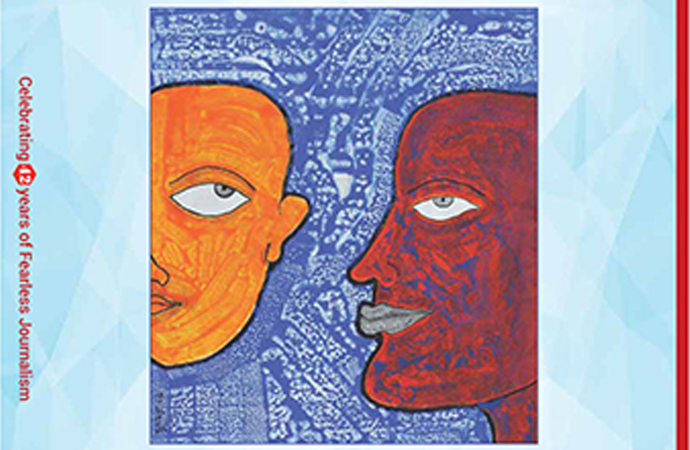Culture

Photographed by Mohaimenul Rakib Nitol. Image courtesy- Brihatta Art Foundation
People bloom amidst the natural landscape of their homeland, imbuing their lives with its various hues and shades. The culture and language of the land form their very identities. The motherland embraces her children in collective unity overcoming differences, cultivating each unique expression of beauty. Bangladesh is a land filled with people that reflect its diverse geography, from the mountainous hill tracts, to the flowing river valleys, to the sandy beaches. This land is a true reflection of the unique people who call Bangladesh their home. It's rivers are its lifeblood, its great connectors, the everchanging waters flowing, carrying stories across the land linking people. So it is only natural that new stories are woven and created down by the river.
It is with this vision, artist Bishwajit Goswami crafted an artistic story rooted in the unique environment of Moheshkhali, creating a new atmosphere of cultural and linguistic exchange. "Maa-Maati-Manush-Swadesh-Bhasha-Prokkriti (Mother-Earth-People-Homeland-Language-Nature)" is a site-specific installation created by the artist on the occasion of International Mother Language Day 2021. The project was undertaken in association with Brihatta Art Foundation. Strengthened by Brihatta's collective spirit, Goswami and the locals of Tsensiraw sought to combine the beauty of nature and the human heart and weave new stories through the massive installation. Alongside this site-specific project, other interactive projects also went on in the space, engaging both children and elders of the community.
The roar of the sea lulled by surrounding hills and the flowing rivers create a unique atmosphere in Moheshkhali, the only island in Bangladesh combining all these natural elements. Located at the southern tip of Bangladesh, Moheshkhali is home to the ethnic Rakhine community. Unchanged by the passage of time, this community retains their culture and language, living in harmony with nature. The people of Moheshkhali are strong believers of Buddhism, with their unique cultural ethnicity rooted in their religious beliefs and in their link with their natural environment.
The preparation session started in Moheshkhali from 17 February 2021, with the main installation erected at midnight on 21st February at the banks of Bakkhali River. The local Rakhine community, along with Bishwajit Goswami and team Brihatta moved together, believing in the age-old adage that our strength lies in our unity. Each day was dedicated to a different activity, with the team cleaning up the site before immersing themselves in creating the massive structural piece and over three thousand paper lanterns necessary to illuminate it. The full coverage of the project, from conception to completion was covered by Brihatta Art Foundation's Facebook page throughout the week, with photos and videos and a final Live session that aired the lighting of the lanterns on 21st February at midnight.
The massive structure was inspired by an older series of Goswami's titled "Travelling with Mother", where he designed a heart-like form inscribed with "Maa" written in Bengali and travelled with the cut-out all over the world, photographing mothers holding it. Both the shape and design of the "Maa heart" was inspired from ubiquitous Bengali rickshaw art. The idea went through several evolutions before it became the design used in the site-specific installation at Moheshkhali. Goswami believes that art is a dynamic process, ever-changing in its creativity. The Rakhine community traditionally erect gigantic illuminated bamboo sculptures to celebrate joyous occasions and so Goswami combined traditional Rakhine structural design with his urbanised Bengali rickshaw art. The installation at the Bakkhali riverbank consisted of two bamboo rickshaw "Maa hearts" (one inscribed in Bengali and one in Rakhine) standing at a towering 50 feet, with wings spanning 200 feet in width. Each wing also carried inscriptions in both Bangla and Rakhine saying, "My Bangla/Rakhine mother tongue". The design was reflected further in the waters of the river, with its ripples and natural flow giving the reflection a life of its own. The disparate designs and colours come together in harmony transforming ancient tales into newer renditions, with the illuminated sculptures appearing to float on the water, ephemeral and everflowing.
Using the lighting of the lanterns as a symbolic gesture, Brihatta Art Foundation hopes to connect the diverse voices of Bangladesh in harmony, linking people and communities. The entire community (youth and elders) were dedicated to make this venture successful, all working on the site alongside Brihatta. Although the winds were strong and extinguished quite a lot of lanterns, the experience of working with nature was unmatched and shaped a new understanding of natural forces. This collective initiative to exchange cultural discipline, identity and language through the universality of the motherland and nature will birth a new enduring story.

























Leave a Comment
Recent Posts
The forensic clean up of the f ...
Much of the coverage centring the surge in Non Performing Loans (NPLs) ...
Hong Kong’s deadliest fire in ...
Hong Kong’s deadliest fire in decades left at least 44 people de ...
False document submission hurts genuine students’ ch ..
The Missing Ingredients for Peace in Palestine
Songs of Hyacinth Boats & Hands: Reading Conversatio ..
Executive Editor Julie Pace on why AP is standing fo ..